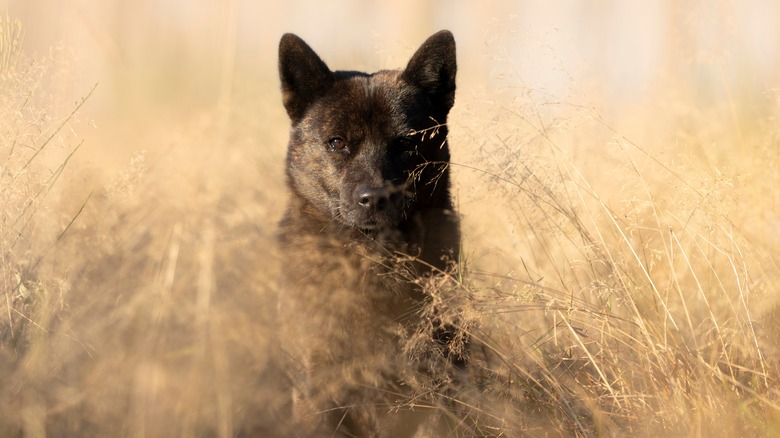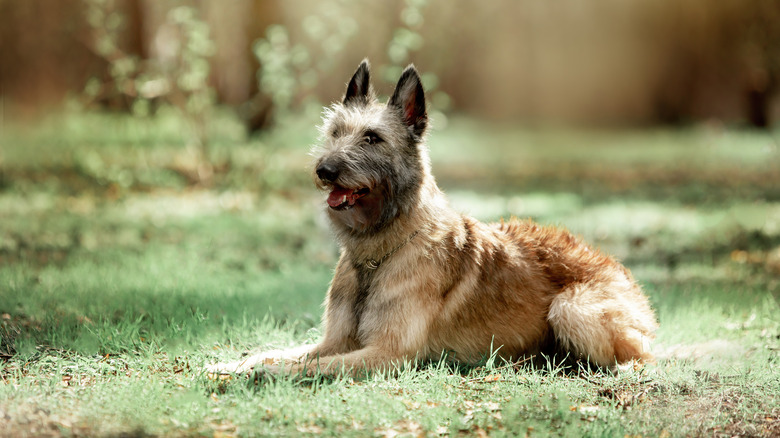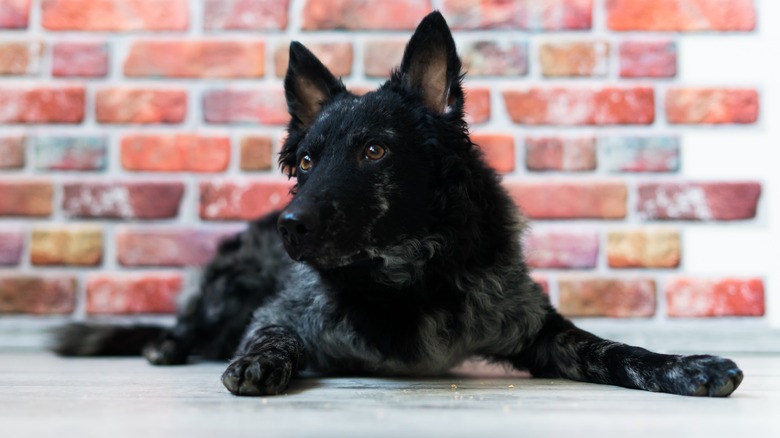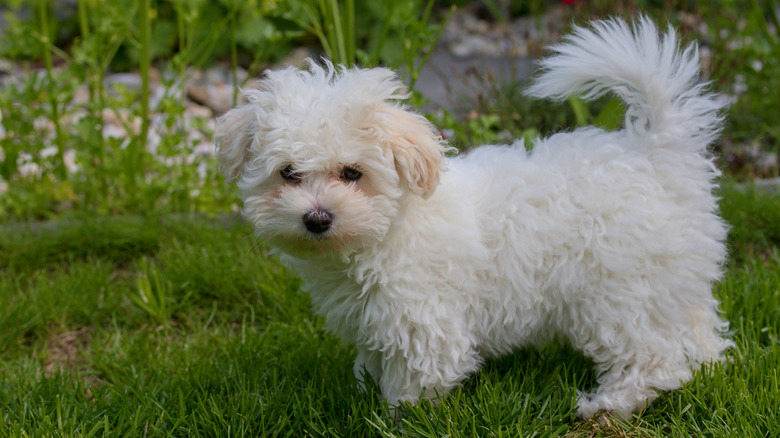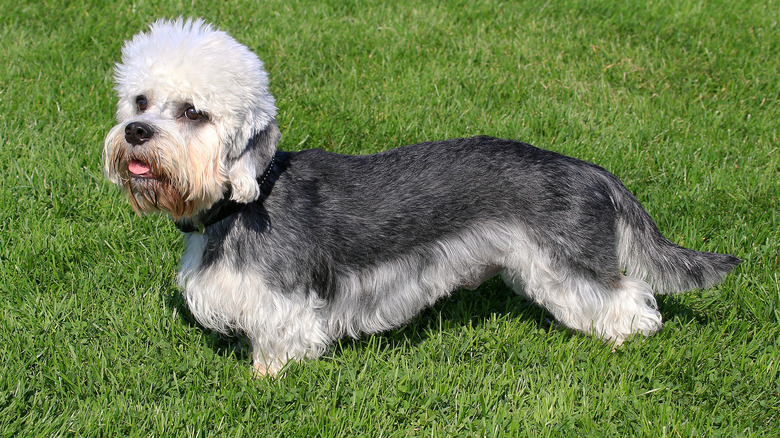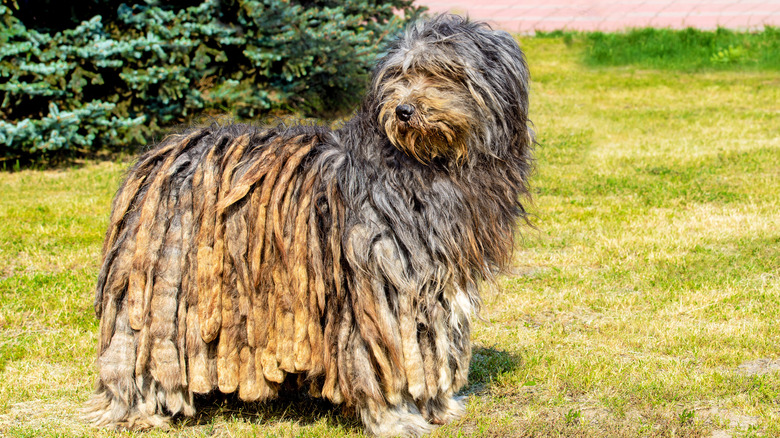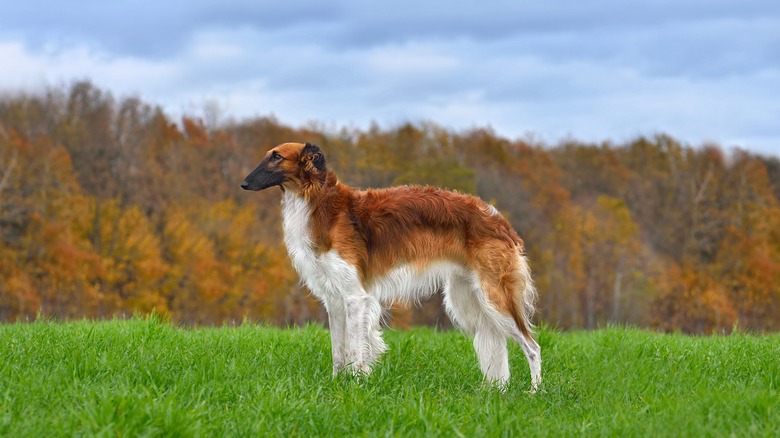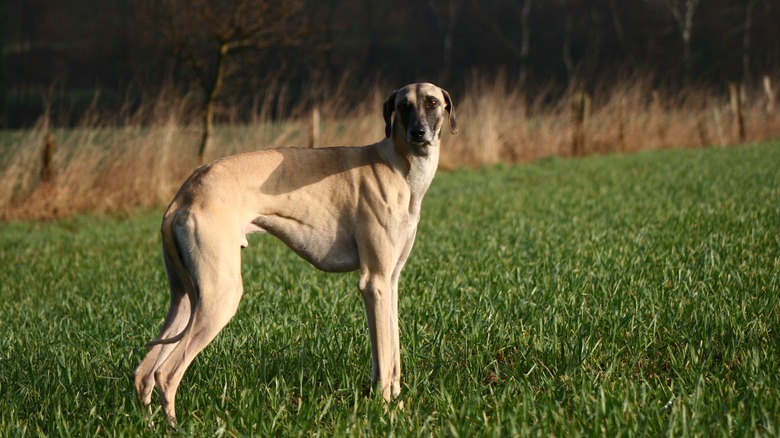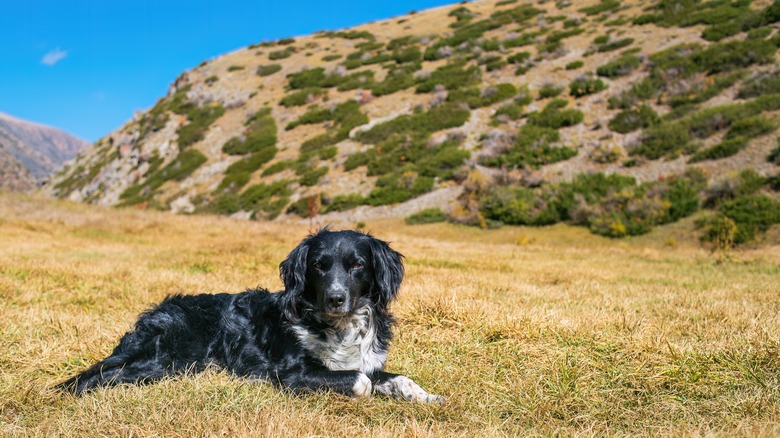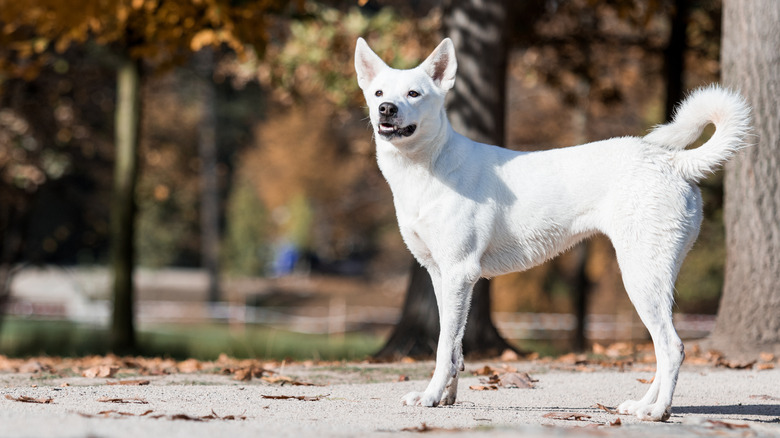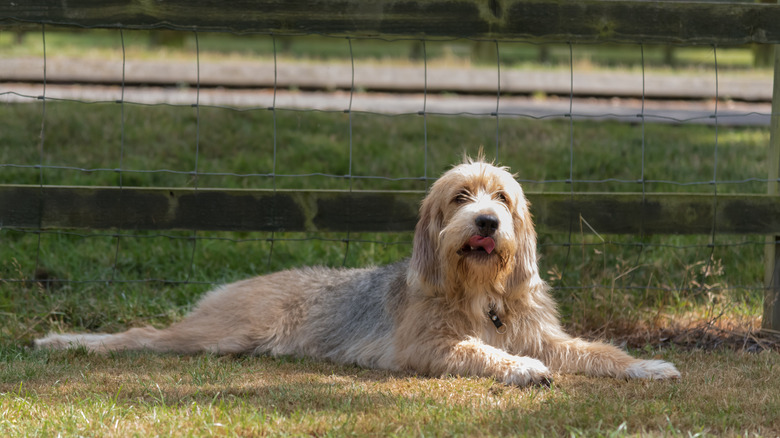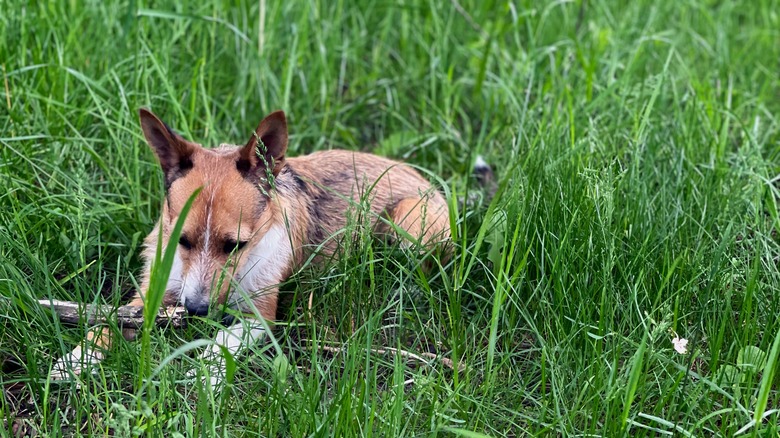Rare Dog Breeds You Probably Never Even Heard Of
If there's one indisputable fact about dogs, it's that they're man's best friend, a moniker they prove true time and again. But did you know, according to the Fédération Cynologique Internationale (FCI), there are at least 356 recognized breeds in the world? Each of these pups has its own distinguishing features and traits that set them apart from the hundreds of others. Some are sporty, some are hard workers, and some make the greatest family pets. There's truly a dog out there for everyone.
Out of the many varieties, you can likely pinpoint some of the most popular dog breeds right off the bat: Chihuahuas, German shepherds, and black Labradors, for example. Yet, for each one you recognize, there are many lesser-known breeds quietly hiding in the shadows. You don't hear of these rare varieties often — or at all. While some make their way to the United States in small numbers, many originate in other countries. These lesser-known breeds deserve their time to shine in the spotlight, too.
Belgian Laekenois
Never heard of this pup before? Don't be surprised, many haven't. The American Kennel Club (AKC) didn't acknowledge the Belgian Laekenois as a breed until 2020 when it joined the Herding group. That doesn't mean it's a new variety by any means; it just lacks exposure, which is surprising considering Adolf Hitler reportedly took out a bounty on it during World War II.
Belgian Laekenois are highly intelligent and resilient, which made them perfect for the Allies to use to send messages, even through battlefields. German forces wanted to eliminate the asset, leading to a significant decline in its population. Many breeders and groups, including the American Belgian Laekenois Association, have dedicated themselves to preserving the canine through responsible practices.
Today, there have been just a few hundred Belgian Laekenois in the United States and only about 1,000 worldwide. These pups aren't for just anyone, though. They need regular exercise and do well when kept busy (think competitive dog sports and those best for herding). In the absence of a dedicated job or sport, they need an active owner who can tire them out.
Mudi
Hailing from Hungary, the mudi is a farm dog that, like the Belgian Laekenois, needs to stay busy. In the post-World War II devastation, the mudi, along with other Hungarian breeds, the pumi and puli, were nearly decimated. Efforts in the 1960s revived them somewhat, but they are still considered one of the rarer dogs with only about 3,000 to 4,000 of them in the world, primarily existing in their homeland. There are just a few hundred in the United States and they're often confused with mixed breeds because of their unique appearance.
One interesting thing about the mudi is that in addition to herding, it also does a spectacular job at vermin control. The breed has a strong prey drive, but fares well with other animals as long as it's exposed and trained from puppyhood. They also excel at search-and-rescue missions.
If you're a first-time dog owner, be prepared to put in a lot of work and consider picking a qualified dog trainer to learn how to get along with and handle the breed. They need to stay occupied, otherwise they can be loud. For this reason, it's recommended that only experienced owners adopt the mudi.
Bolognese
There are more than a dozen small, white dog breeds in the world. However, one of the rarer pups to fall within this category is the Bolognese. More than just a delicious pasta dish, the dog breed was once prolific among European nobility especially in Italy, where it originally hails from. However, when the aristocracy began to disappear, the Bolognese followed suit. Despite enthusiasts' efforts to save the breed, it still isn't a widely known type. Bolognese dogs were largely seen as graceful and beautiful, often sitting by its noble owner's side and depicted in Renaissance art. It's part of the Bichon family and is commonly confused with other breeds due to its low profile.
If you're a relax-at-home kind of person or remote worker, the Bolognese could be the perfect pup for you. A companion dog, the breed is known for its docile nature, though it does have playful spurts. It's content to sit by your side for hours. Since it tends to suffer from separation anxiety, the Bolognese should not live with someone who is never home. One added perk is that the breed is a non-shedding dog, so if you own one, you'll be sweeping a lot less. Their long life expectancy means they fit in with the longest living dog breeds.
Dandie Dinmont Terrier
If you think this sounds like the name of a cartoon character, you wouldn't be far off. A real rarity, the Dandie Dinmont terrier is a Scottish breed named after a character in Sir Walter Scott's 1815 novel, "Guy Mannering." It's an uncommon dog to see, and not many are registered each year.
The Dandie Dinmont terrier has been around for approximately 400 years, dating back to at least the 1700s. It was originally bred from rough terriers to hunt badgers and otters, which it was wildly successful at. Hunting vermin was outlawed in the U.K. in the late 1900s, which relegated the breed to serving as a companion dog. It differs from other terriers in that it has a large, domed head and a curved spine and tail.
Dandie Dinmont terriers may be small, but what they lack in size, they make up for in personality. They are smart but stubborn, which could lead to some training problems if there's no consistency. It's also quite a fearless breed. Though they're not overtly high maintenance, Dandie Dinmont terriers require regular grooming to keep their fur from tangling and matting. Brushing every two days will suffice, and the breed should have its coat stripped to remove dead hair but never trimmed.
Bergamasco shepherd
Did someone call for an extra mop? Nope, that's just the Bergamasco shepherd, sometimes referred to as the Bergamasco sheepdog, one of the rarer dog breeds in the world. It's hundreds of years old, yet remains relatively undiscovered outside of Italy. The Bergamasco earned its name herding sheep, but its existence was threatened after World War II when the demand for wool went down. One of the breeders responsible for the Bergamasco's continued existence is Dr. Maria Andreoli, who spent decades working to revitalize them.
The Bergamasco shepherd's coat might look like a grooming nightmare, but once it's fully developed, it needs little care beyond a few baths annually. The coat is comprised of an undercoat, a wooly outer coat, and the layer in between, referred to as goat hair because of its coarseness. It naturally felts on its own and requires its owner to separate those felts into mats. You would think the thick strands would cause overheating in the summer, but they're designed in such a way that they actually keep the pup cool, even in hot temperatures.
Borzoi
The Borzoi is an older dog breed with a heritage that dates back to the 1600s when it walked alongside the aristocracy. Originally called the Russian Wolfhound, the Borzoi, Russian for "swift," underwent a name change in 1936 amid much controversy. A sighthound that uses its vision and speed to hunt, it was bred from Arabian Greyhounds, which resulted in its sleek body type. It was used to hunt wild game, such as foxes, hares, and wolves, the latter of which resulted in its first name.
In the 1800s, the dog was very popular in Russia, the spotlight of hunting events where it showcased its strengths in catching rabbits and wolves. For the latter, the Borzoi worked in teams to detain the animal until the hunter took over. Known for its speed, the Borzoi is excellent at agility sports, particularly lure coursing, where a pulley drags a plastic lure representing prey across a field and the pup is released to "chase" it down.
The Borzoi population severely dwindled during the Russian Revolution and since there were restrictions on its ability to leave the country's borders, it rarely got the exposure it deserved. However, in the 1900s, Americans helped Russians re-establish the dog after they worked to restore the breed to its glory.
Sloughi
Like the Borzoi, the Sloughi is a sighthound bred for hunting game, most notably, foxes, hares, gazelles, and even jackals. The breed may date back to 8000 B.C. The Sloughi has North African origins and is accustomed to living in desert regions, thriving in the dry heat. It is considered a rare breed, as it's not commonly heard of outside North Africa, though it made it to the United States in the 1970s. It wasn't until 1981 that the first American litter of the breed was born. The AKC fully recognized it in 2016.
The Sloughi had to overcome significant obstacles, including World War II, a rabies epidemic, and the outlawing of hunting with sighthounds in Algeria and Morocco, two countries where the breed was prominent. Its numbers significantly declined following these events, until enthusiasts undertook efforts to revive the population. Today, it's far more common in Europe than in the United States, though the West had a hand in preserving the Sloughi. Fast and agile, the breed appears in competitions, including lure courses. It's one of the fastest dog breeds, as it can reach dizzying speeds of up to 42 miles per hour thanks to its lean body.
Stabyhoun
Take one look at the Stabyhoun and you can tell it's ready to work. This sporting breed has Dutch origins and is commonly used for water work, pointing, and retrieving. It stands out due to its ability to excel at multiple tasks. However, the Stabyhoun was bred with independence in mind so it could go off and hunt small game and bring it back to its owner.
There are approximately 6,000 of these pups worldwide, and just 300 or so in North America, making them one of the rarest dogs in the world. The AKC recognizes the breed, but only as part of its Foundation Stock Service. On the other hand, the FCI recognizes it as part of its Group 7, Pointing Dogs category.
While the Stabyhoun is often independent, it also has a way of finding trouble due to its curious nature. Consistent training is a must with this breed, so it's a good idea to familiarize yourself with common dog training terminology. Since it was bred as a hunting dog, it has a high prey drive and will likely spend a good amount of time outside digging for vermin.
Canaan dog
Once an all-around dog used in times of war, the Canaan dog today is largely a service or family pet. The breed has existed in the Middle East since at least B.C. times, but remains mostly unheard of outside its origin country of Israel. In 70 A.D., Israelites fled Judea and may have left their dogs behind. Many Canaans returned to their wild roots for centuries. It wasn't until the 1900s that people focused on domesticating them again.
The breed's intelligence means it's successful at many tasks. During World War II, it was regularly used for detecting mines, tracking, delivering messages, and guarding. Following that, the Canaan dog guarded flocks and homes. It developed from pariah (wild) dogs utilized for guarding and hunting. It was nearly killed off in the late 1900s following an attempt to eliminate rabies. Canaan dogs can be amazing pets — but not without some work. It's a bit of a stubborn breed that has, as a previous wild dog, maintained its wariness. Plus, it has a prey drive that may make it unsuitable for homes with small children or other animals.
Otterhound
The otterhound is one of the rarest dogs in the world with fewer than 1,000 in existence. Though it often resembles and is confused with mutts, it's a purebred dog that deserves recognition as such. Originally, it was tasked with the job of hunting river otters. At first, the practice was to protect the fish population, but it later became sport. When the activity was outlawed in the 1970s, the otterhound nearly went extinct. The breed is known for its exceptional tracking skills, thanks to its sensitive sense of smell. For this reason, it would excel in tracking sports.
It has a double coat, with a water-resistant undercoat and a rough outer coat. It can be tempting to shave an otterhound in the warmer months of the year, but its coat is specifically designed to keep it cool in the summer and warm in the winter. In fact, shaving this pup could lead to an increased risk of it overheating. Beyond weekly brushing and the occasional bath, the grooming requirement is minimal. Otterhounds make great family pets because they are joyous animals. They tend to be large, so caution with children is necessary, and don't be surprised if they, even at 100+ pounds, try to crawl into your lap.
Norwegian lundehund
One of the rarest dogs of all, the Norwegian lundehund kind of looks like a fox. It was bred with the sole purpose of hunting puffin, a black and white seabird with a colorful beak. Some puffins are now a protected species, which means people can no longer hunt them, and thus the number of Norwegian lundehunds in the world has declined. It's so rare that it often bottoms out on the list of popularity and number of dogs registered each year.
The breed has several distinguishing features that set it apart. For example, it has six toes on each foot, two of which act like thumbs do on humans. The extra toes give the Norwegian lundehund additional traction. The breed, known for digging into burrows to hunt puffins years ago, can also control its ears to the extent that it can close its ear canals to prevent debris and water from getting inside and causing irritation or health issues. And if that wasn't impressive enough, it's also quite flexible, which allows it to navigate in burrows and prevent itself from falling.
In the early 1930s, the population of Norwegian lundehunds was sparse. The only purebred ones were secluded on Lovunden and Værøy, Norwegian islands. Breeder Eleanor Christie heard about the pup's plight and sought to save them from extinction. It worked, though there still aren't very many in the world today.
Kai Ken
The Kai Ken is a native Japanese breed, one of only six hailing from the Asian nation. To see one is rare, even in its home country, where it has been designated a natural monument. It's not clear exactly why their numbers are few. Where many Japanese dog breeds, such as the Shiba Inu and Akita, are independent, the Kai Ken is more eager to make its humans happy and does better with interaction. In fact, they benefit from a great deal of attention on a daily basis. It's also commonly referred to in Japan as a Kai-inu or a Tora inu.
The Kai Ken is a breed commonly used to hunt game in Japan's mountains. It is also unique in that it has the ability to climb trees in pursuit of its prey. Though puppies are usually born solid black, in adulthood, the Kai Ken has a brindle coat that may be black, red, or brown, which helps it blend in with its surroundings. Like other Japanese breeds, the Kai Ken is a very clean dog that requires minimal maintenance in terms of bathing. A blowout twice a year to remove its undercoat can help with shedding.
